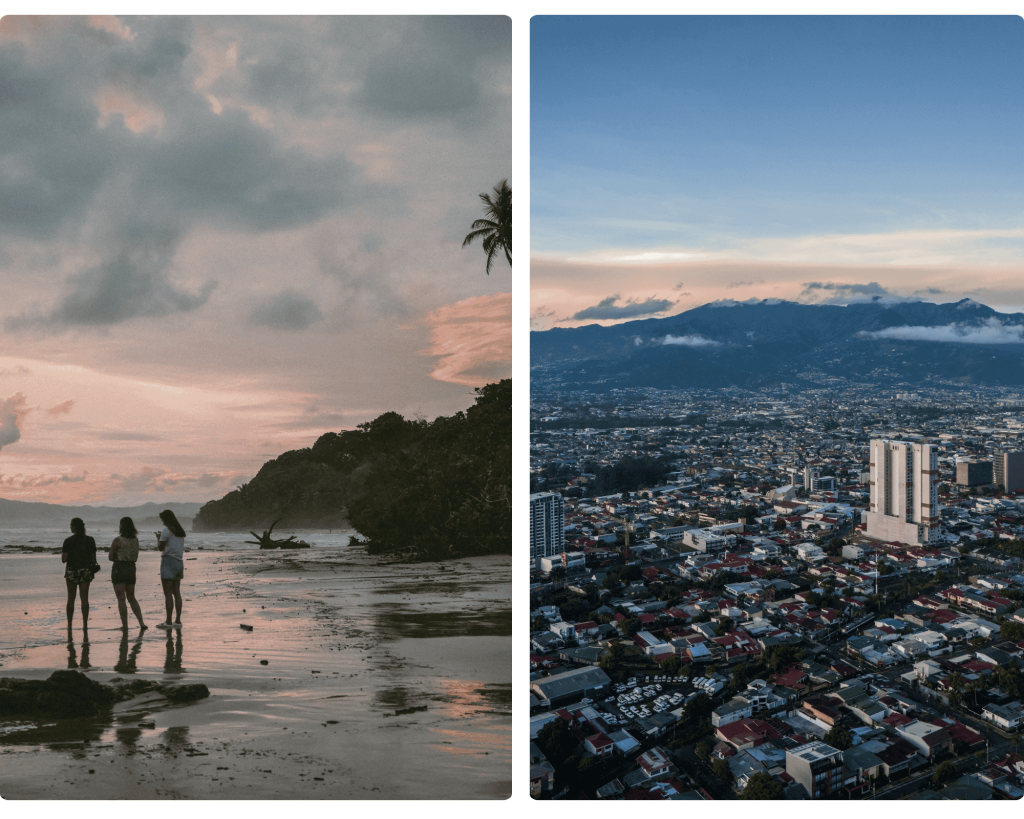Costa Rica for Digital Nomads: A Comprehensive Guide
Your must-have guide to experiencing Costa Rica as a digital nomad. We review the available options for accommodation, networking and more.
As a digital nomad who is thinking of settling in Costa Rica, it is imperative that you have a guide that provides you with information on all available options for accommodation, living costs and leisure at your fingertips. Costa Rica is a country located in Central America, with a geographical position that invites you to navigate and get to know the different corners it has to offer. Corners such as Santa Teresa or San José, its representative capital.
In this article, we review the updated prices of accommodation in the main Costa Rican destinations, how you can travel, what kind of visa you can apply for to stay more than 90 days in this country, and in general, what are the most important things to bear in mind as a digital nomad in Costa Rica. Let’s get to it!
Why choose Costa Rica to live as a digital nomad?
To answer this question, let us review some important points:
1. Connecting with nature and outdoor adventure
The country is home to more than 5% of the world’s biodiversity, offering digital nomads the opportunity to enjoy outdoor activities such as surfing, hiking and wildlife spotting. National parks such as Manuel Antonio, Corcovado and Arenal Volcano offer unique experiences for those looking to explore and disconnect from work.
2. Quality of life and focus on well-being
Costa Rica is known for its tranquil and healthy lifestyle, reflected in the concept of living the “pura vida” outlook on life. The population enjoys a high life expectancy, and the country promotes a strong connection with nature, encouraging a work-life balance. This makes it an ideal destination for those who prioritise wellbeing.
3. International community and networking
The digital nomad community in Costa Rica is constantly growing. In cities such as San José, Tamarindo and Santa Teresa, these communities organise social events, networking activities and professional meetings. Facilitating the creation of both work and personal networks.
Costa Rica has been improving its infrastructure to attract the digital nomad community, with a notable growth in co-living and coworking spaces. What’s more, the country is committed to clean energy, which resonates with people seeking a more sustainable lifestyle.
4. Political stability and security
Costa Rica is one of the most stable countries in Latin America. It has not had an army since 1948, which has allowed it to concentrate resources on health, education and social development. It also provides a safe environment for those moving in temporarily or permanently.
5. Easy access to international flights
Costa Rica has two main international airports: Juan Santamaría Airport in San José and Daniel Oduber Airport in Liberia, which facilitates travel to North America, Europe and other Latin American destinations.
Visas allowing legal residence in Costa Rica
Digital nomad visa for Costa Rica
Since 2021, Costa Rica has had in place its visa for digital nomads, which allows them to reside in the country for an initial period of 12 months, with the option to renew for another year. The main requirements are:
- Minimum income of $3,000 per month, or $4,000 if travelling with dependents.
- Medical insurance valid for the duration of the stay.
- Proof of remote employment or freelance income.
Advantages of the visa: It allows you to work remotely and offers benefits such as tax exemption on electronic equipment needed to work and the possibility to open local bank accounts.
Tourist visa with extension option
For those who do not wish to apply for a nomad visa from the outset, the tourist visa allows a stay of up to 90 days. Many digital nomads resort to visa runs, i.e. leaving the country briefly to obtain a new visa on re-entry. However, this method does not always guarantee an extended stay.
Change to other types of visas
Some nomads who start with a digital nomad or tourist visa later opt to apply for temporary or permanent residency, especially if they decide to settle long-term or open a business in Costa Rica.

Where to live and work as a digital nomad in Costa Rica
Long-term accommodation and co-living options
Co-living spaces in Costa Rica have adapted to the digital nomad lifestyle, offering spaces that combine accommodation and work areas. Tamarindo, Nosara and Santa Teresa are some of the most popular areas for co-living spaces, as they combine the beach, nature and an international community.
If you prefer independent accommodation, Airbnb and websites specialising in long-term rentals are common options. Depending on the location and type of housing, prices can vary significantly. In cities, furnished flats can cost between $400 and $1,500 per month, while in more touristy or coastal areas prices can increase during the high season.
San José: the capital with coworking options
San José is the economic and cultural centre of the country. Here you will find modern coworking spaces, such as WeWork and Selina, as well as a wide range of high-speed internet cafés. The capital also offers cultural events and is a central point for travel to other regions of the country.
- Accommodation: In San José you can find furnished flats and co-living options from $400 to $900 per month.
- Coworking: Spaces such as Impact Hub and Selina offer rates ranging from $150 to $300 per month.
Tamarindo: Seaside living and surfing
Tamarindo, in the province of Guanacaste, is popular for its beaches and relaxed atmosphere. The city has attracted a large community of digital nomads, migrants and travellers. Plus the coworking options, many prefer to work from cafés overlooking the sea.
- Accommodation: from $600 in shared flats to luxury villas for $2,000.
- Coworking: Spaces such as Tamarindo Coworking have daily plans from $15 and monthly plans for $250.
Santa Teresa: Bohemian and creative destination
Santa Teresa is a quiet retreat, ideal for those seeking a more relaxed atmosphere. Although the infrastructure is more limited compared to San José or Tamarindo, the creative community and the proximity to the sea make it a special destination for work and relaxation.
Puerto Viejo: Relaxed atmosphere in the Caribbean
Puerto Viejo, located on the Caribbean coast, is known for its relaxed atmosphere, white sandy beaches and Afro-Caribbean culture. This destination is ideal for digital nomads seeking a quiet lifestyle, surrounded by nature and with a focus on communal living.
- Accommodation: Choice is varied, with bungalows, hostels and temporary rentals ranging from $400 to $1,200 per month.
- Connectivity: Although internet in some areas is slower, several cafes and hostels offer stable connection for working.
Nosara: Yoga, wellness and remote work
Nosara, on the Nicoya Peninsula, is a popular destination for people interested in yoga, wellness and surfing. Its tranquil atmosphere appeals to those who prefer to work at a leisurely pace while enjoying meditation and reconnecting with nature.
- Coworking: Several centres and studios offer spaces where yoga classes are combined with work areas.
- Accommodation: From $800 in shared rooms to more luxurious options costing more than $2,500 per month.
Taxes to be aware of in Costa Rica
Territorial tax system
Costa Rica applies a territorial tax system, which means that only income generated within the country is taxed. Therefore, digital nomads working for foreign companies or as freelancers for international clients generally do not have to pay local taxes.
Double taxation treaties
Costa Rica has tax agreements with several countries to avoid double taxation, which means that some workers will not have to pay taxes in their home country and in Costa Rica simultaneously. Check these treaties according to your nationality to avoid tax surprises is advised. Some countries include: Germany, Spain, Mexico and the United Arab Emirates.
Important: If you are a frequent traveler and want to stay connected without worrying about expensive roaming or looking for a new SIM at every destination, Holafly’s subscription plans are for you. With a single eSIM, enjoy internet in more than 170 countries for a fixed price and no surprises on your bill. travel without limits and connect easily and securely! 🚀🌍

Health and medical insurance for digital nomads in Costa Rica
Public system and private insurance
The public health system, known as the Caja Costarricense de Seguro Social (CCSS), is available to legal residents. However, many nomads prefer to take out private insurance because of the speed of care at hospitals such as CIMA Hospital and Clínica Bíblica.
- Recommended insurance:
- SafetyWing: This has flexible coverage for travellers and digital nomads.
- World Nomads: Suitable for extended stays and emergencies.
- Language: In private clinics it is common to find English-speaking medical staff, which facilitates communication for those who are not fluent in Spanish.
Daily life in Costa Rica
Transport and mobility in Costa Rica
Public transport: Costa Rica has a variety of options such as buses and taxis. Intercity buses are affordable, with fares ranging from $1 to $10, depending on the route. In major cities such as San José, bus services cover urban routes well. However, the system can be a little confusing in some areas due to the lack of digital map updates.
Taxis and private transport: In addition to traditional taxis (which use a meter), platforms such as Uber operate in most major cities. Uber costs are generally cheaper than conventional taxis.
Driving in Costa Rica: If you plan to rent a car, you can use your foreign driving licence for up to 90 days. Afterwards, a local licence is required if you decide to extend your stay. Roads can vary in quality, with some being well surfaced and others more challenging, especially in rural areas.
Managing your finances as a digital nomad in Costa Rica
Recommended banks: Local banks such as Banco Nacional and BAC Credomatic are popular with residents and foreigners. In any case, digital banking options such as Wise or Revolut offer advantages for digital nomads by reducing fees for international transactions.
Cash withdrawals: Automatic teller machines (ATMs) are common in cities, but some rural areas have less access. It is important to check the fees, as they can charge between $3 and $5 per withdrawal.
Digital payments: Debit and credit cards are widely used, although in local markets and small shops it is preferable to carry cash in colones (the official currency).
Food for digital nomads in Costa Rica
Supermarkets: The best known chains are Walmart, Automercado and Maxi Pali. There are also local markets where you can buy fresh fruit and organic produce at more affordable prices.
Average cost: Eating in a local restaurant (soda) costs between $5 and $8 per meal. In more exclusive restaurants, the price can exceed $25 per person.
Gastronomic recommendations: Don’t miss the gallo pinto (a typical dish based on rice and beans), Costa Rican ceviche and beef stew.
Leisure and free time for a digital nomad in Costa Rica
Outdoor activities: Costa Rica is an ecotourism paradise. Nomads can enjoy activities such as hiking in national parks (Manuel Antonio, Corcovado), surfing in Tamarindo and Santa Teresa, or exploring the Arenal and Poas volcanoes.
Gyms and sports: There are gyms and yoga centres in major cities. In coastal areas, surfing is one of the most popular activities.
Festivals and culture: The country hosts several festivals, including the International Festival of the Arts in San José and the Palmares Festival. These events offer an excellent opportunity to connect with local culture.
Nightlife and cultural entertainment in Costa Rica
Nightlife: Costa Rican cities such as San José, Tamarindo and Jacó offer a vibrant nightlife with bars, clubs and pubs that attract both locals and digital nomads. In San José, Barrio Escalante is known for its craft beer bars and live music venues. In coastal areas such as Tamarindo, beach clubs and beach parties are popular, especially during the high tourist season.
Local culture: Costa Rica also has a strong cultural identity. In San José you can find museums such as the Pre-Columbian Gold Museum and the National Museum of Costa Rica, where you can explore local history and traditions. Traditional dance and music, such as cumbia and calypso, are essential elements of local festivals and events.
Networks and communities of digital nomads in Costa Rica
Costa Rica has gained popularity among digital nomads, and there are multiple communities and groups to help you integrate. Facebook groups and platforms such as Meetup organise social and networking events for travellers and remote workers. In cities such as Tamarindo and Puerto Viejo, co-living spaces offer specific programmes to create a collaborative community among nomads.
Some local communities focus on wellness and outdoor activities, such as yoga retreats and surf camps. These experiences offer not only spaces to relax, but also opportunities to meet other travellers and remote professionals.
Best time to visit Costa Rica
Climate: Costa Rica has two seasons: the dry season (December to April) and the rainy season (May to November). The dry season is ideal for beaches and outdoor activities, while the rainy season is perfect for exploring jungles and enjoying lower accommodation rates.
Events and festivities: Between December and January, cities celebrate Christmas and New Year with parades and cultural events. In April, the country celebrates Holy Week, with traditional processions in different regions.

Cost of living as a digital nomad in Costa Rica
Accommodation:
- Co-living spaces: $400 – $1,500 per month (or even a little more depending on the conditions and luxuries offered).
- Flat rentals: From $600 in rural areas to $2,500 in urban areas.
Coworking spaces:
- In San José: Prices range from $150 to $250 per month.
- In Tamarindo and Santa Teresa: Spaces are available for 10 – 15 dollars per day.
Food:
- Monthly food expenses: Approximately 300 – 500 USD.
Transport:
- Public transport: $40 – $80 per month.
- Car rental: from $500 per month.
Leisure and entertainment:
- Gym membership: $50 – $70 per month.
- Outdoor activities and tours: $20 – $100, depending on experience.
Costa Rica is an excellent choice for digital nomads seeking a balance between work and nature. With its growing infrastructure for remote workers, flexible visa options and active international community, this destination guarantees an enriching experience.
Additional tips for your experience as a digital nomad in Costa Rica
Language: Spanish is the official language, but many people in tourist areas also speak English. If Spanish is not your native language, it is ideal to learn it, as it facilitates integration and improves your day-to-day experience.
Security: Costa Rica is one of the safest countries in Central America, but as in any tourist destination, it is important to be aware of thieves in crowded areas or markets. The more touristy areas are usually quite safe, but it is best to take precautions and ask locals for references.
Environmental impact: The country is known for its focus on sustainability and ecotourism. As a digital nomad, you can contribute to reducing your environmental impact by choosing sustainable accommodation options and participating in responsible tourism activities.
Tips to setting up as a digital nomad in Costa Rica?
- Apply for an appropriate visa: If you plan to stay longer than 90 days, look into visa extension or options to change your visa. Here we’ve mentioned your options, the digital nomad visa or the extension of the tourist visa.
- Join local communities: Participating in events and social groups can make your experience more holistic.
- Manage your time: As Costa Rica offers so many outdoor activities, finding a balance between work and leisure is recommended.
- Take advantage of digital infrastructure: Connect to coworking spaces or public areas with free Wi-Fi to improve your productivity.
Costa Rica is an ideal destination for digital nomads thanks to its tropical climate, quality of life and growing traveller communities. With a combination of stunning natural scenery, adequate infrastructure and entertainment options. Living and working in Costa Rica is a rewarding experience for those seeking a remote lifestyle.





 Language
Language 


















 No results found
No results found








